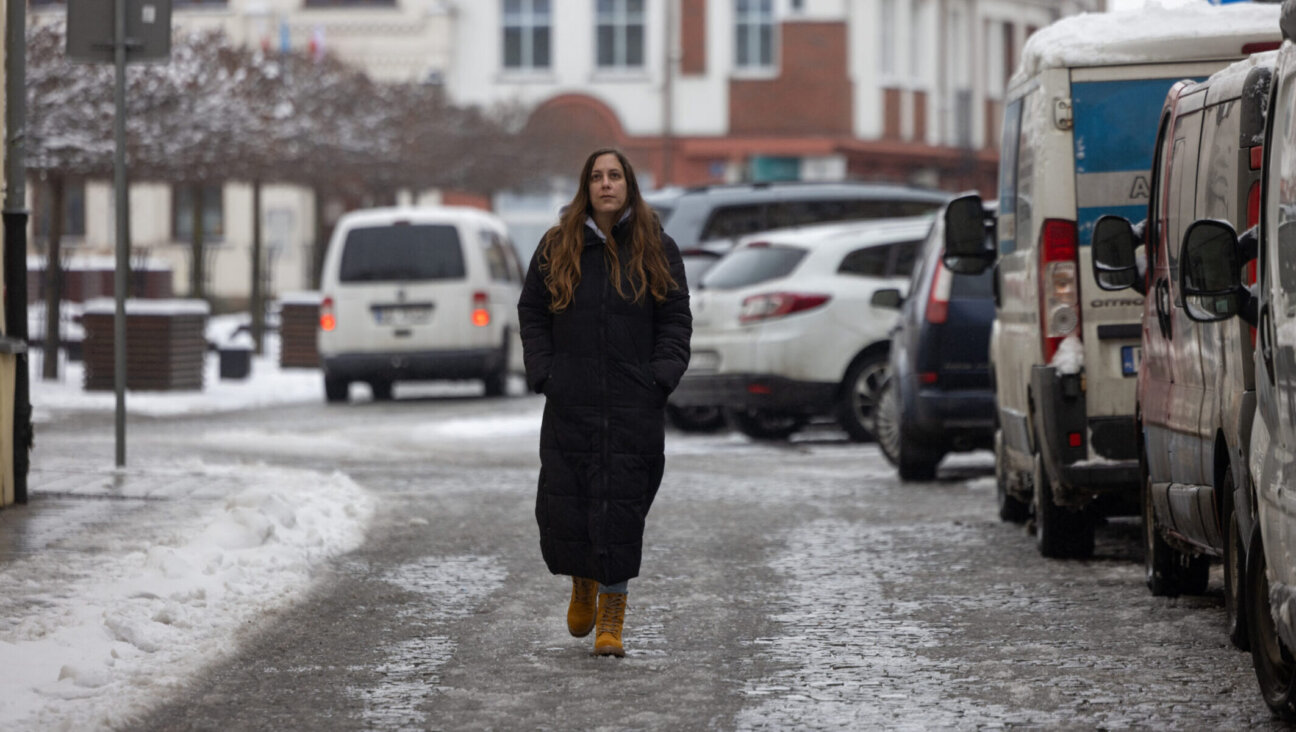Mixed-heritage Family Deals With Genetic Tragedy
When Rachaeli Fier uttered her first word — abba, or father — her parents had no idea it would be her last. Rachaeli was born a perfect baby girl, a “designer baby,” as the hospital’s delivery staff called her. Now, Eric and Nicole Fier watch helplessly as Rachaeli spirals downward in rapid, steady regression. Two-and-a-half-year-old Rachaeli, in the throes of a cruel, degenerative disease, is fading away.
In many ways the Fier story is an unusual one. But the seemingly random coincidences that landed Eric and Nicole with a child whose life will be cut short by the lysosomal storage disease Tay-Sachs are, according to Eric, anything but random. “This was too far-fetched to be merely happenstance,” he said.
Nicole is of mixed Philippine and Dutch descent. Eric is an Ashkenazic Jew. A convert to Judaism, Nicole grew up in White Plains, N.Y., where her family belonged to the local Catholic Church. She first heard of Tay-Sachs while serving as a medical student at the Albert Einstein College of Medicine of Yeshiva University. But it was one on a long list of Ashkenazic Jewish diseases and she had never encountered anyone with Tay-Sachs. Her parents, she said, had never even heard of the disease.
When the couple was expecting their first child in 1994, Eric, whose sister had tested positive as a carrier for Tay-Sachs, got screened in a Pittsburgh laboratory. “The presumption was that it would be a non-issue regardless,” with Nicole being “so far removed from anything even vaguely Eastern European,” Eric said. But it “seemed like the prudent thing to do.”
The results were negative and Nicole gave birth to a healthy baby boy. Two healthy boys followed, and then the couple’s first girl.
Rachaeli was born full-term, after an easy pregnancy that showed no indications of anything amiss. The nurses, said Nicole, marveled at the baby’s perfect appearance.
But while the family fussed over their beautiful baby, Eric, a psychiatrist with an extensive background in pediatrics, found himself holding back. “I knew in my heart of hearts that she was sick,” he said. “I think some part of me even withheld from bonding during the first six to nine months” of Rachaeli’s life.
At three months, Eric began pointing things out to Nicole that seemed to indicate developmental delays. “Rachaeli was not quite doing what they [the boys] did,” but Nicole chalked it up to a difference in gender developmental patterns. When Rachaeli was nine months old, the family pediatrician diagnosed the infant with muscle hyptonia, a general term indicating low muscle tone, something that could be corrected through intensive therapy, which the Fiers began immediately. Included in the list of possible causes for their daughter’s low muscle tone was Tay-Sachs disease, but “we crossed it off because that was definitely not a possibility,” said Nicole.
Shortly after her first birthday, Rachaeli suffered two severe asthma attacks. A thorough examination showed that the infant had an enlarged liver and that she reacted with extreme startle to even the slightest movements, both key symptoms of lysosomal storage diseases.
Eric had tested for Tay-Sachs exclusively, so while the couple looked through the list of diseases Rachaeli possibly could have, they wondered which of the other various diseases — all of them severe — was the least of the evils.
“It’s a thoroughly miserable moment, sitting there with a list of terminal diagnoses, and deciding what to pray for,” Eric said. The diagnosis was not long in coming. Rachaeli became the second Tay-Sachs baby in the state of Georgia in a decade.
New screenings showed that Eric was a carrier of the Ashkenazic genetic mutation for Tay-Sachs disease. His earlier tests, it turned out, had screened only for enzyme level, but the lab had strangely set the cutoff at 50. While Eric’s enzyme level was 51, his results had only said he was negative, without notifying him how nearly a carrier he actually was, even by that lab’s standards. Most labs consider 65 to 70 to be the cutoff for carriers.
But Nicole’s carrier status came as an even greater shock to the couple, and to friends and family who mistakenly assumed the disease to be a uniquely Jewish phenomenon. While carrier rates among Ashkenazic Jews are high — one in 27 — Tay-Sachs is not exclusively a Jewish disease. French Canadians and Louisiana Cajuns are at a similar risk as Ashkenazic Jews for the disease, and the carrier rate among the general population, regardless of ethnicity, is one in 250.
“We need to reach out to the Jewish community, because they are at a high risk,” said Jayne Gershkowitz, director of National Tay Sachs and Allied Diseases Association, but “we need to reach them with all the realities.” Today, widespread screening has significantly reduced the number of Jewish patients with the disease and two-thirds of Tay-Sachs patients are not Jewish. By talking about Tay-Sachs as a Jewish disease, we risk not reaching others in the general population who can be affected unknowingly by a terminal, degenerative illness, Gershkowitz said.
In her work at NTSAD, Gershkowitz has come across numerous interfaith and inter-ethnic couples who have become witnesses to the steady regression, and finally death, of their beloved children. In the case of non-Jewish couples, getting an accurate diagnosis can be even more difficult, as doctors themselves are still sometimes unaware that the disease can affect people from any ethnic background, and will rule Tay-Sachs out based on a couple’s ethnicity.
In the past year-and-a-half since Rachaeli’s diagnosis, Nicole has had to quit her job as a psychiatrist so that she can give her daughter the full-time care she requires. A vibrating vest helps strengthen Rachaeli’s lungs, and a predigested formula fed through an opening in her stomach eases the digestive process. The Fiers considered a stem-cell transplant, but at Rachaeli’s age the risks were so high, there was only a tiny chance she would even survive the ordeal. No other treatments are available, so the Fiers place a priority on making Rachaeli comfortable and concentrating a lifetime of love in the brief space of her time with them. This summer the Fiers are traveling to Israel, a trip that entailed months of preparation.
One year after the diagnosis, Eric launched a Web site, www.rachaeli.com, dedicated to his daughter. The boys, aged 4, 7 and 9, shower their little sister with affection, and are coming to grips with what it means for her time with them, each on his own developmental level.
Life expectancy for infants with Tay-Sachs is typically 2 to 5 years. As Rachaeli loses function, her parents strain to see signs that she recognizes them in the barest movements of her lips and eyes.
The family feels blessed, nonetheless. An unforgiving mistake, “a perceived tragedy,” Eric said, has enriched the family in so many ways. “The possibility that we would have chosen not to have her, had we known, is increasingly foreign to accept,” he said. Had the couple found out earlier that they were both carriers, he said, “we might not have had our boys. Who knows how different our lives would have been? At this point I feel like there were too many coincidences that brought us where we are for this to be just a mistake.”
A message from our Publisher & CEO Rachel Fishman Feddersen

I hope you appreciated this article. Before you go, I’d like to ask you to please support the Forward’s award-winning, nonprofit journalism so that we can be prepared for whatever news 2025 brings.
At a time when other newsrooms are closing or cutting back, the Forward has removed its paywall and invested additional resources to report on the ground from Israel and around the U.S. on the impact of the war, rising antisemitism and polarized discourse.
Readers like you make it all possible. Support our work by becoming a Forward Member and connect with our journalism and your community.
— Rachel Fishman Feddersen, Publisher and CEO























